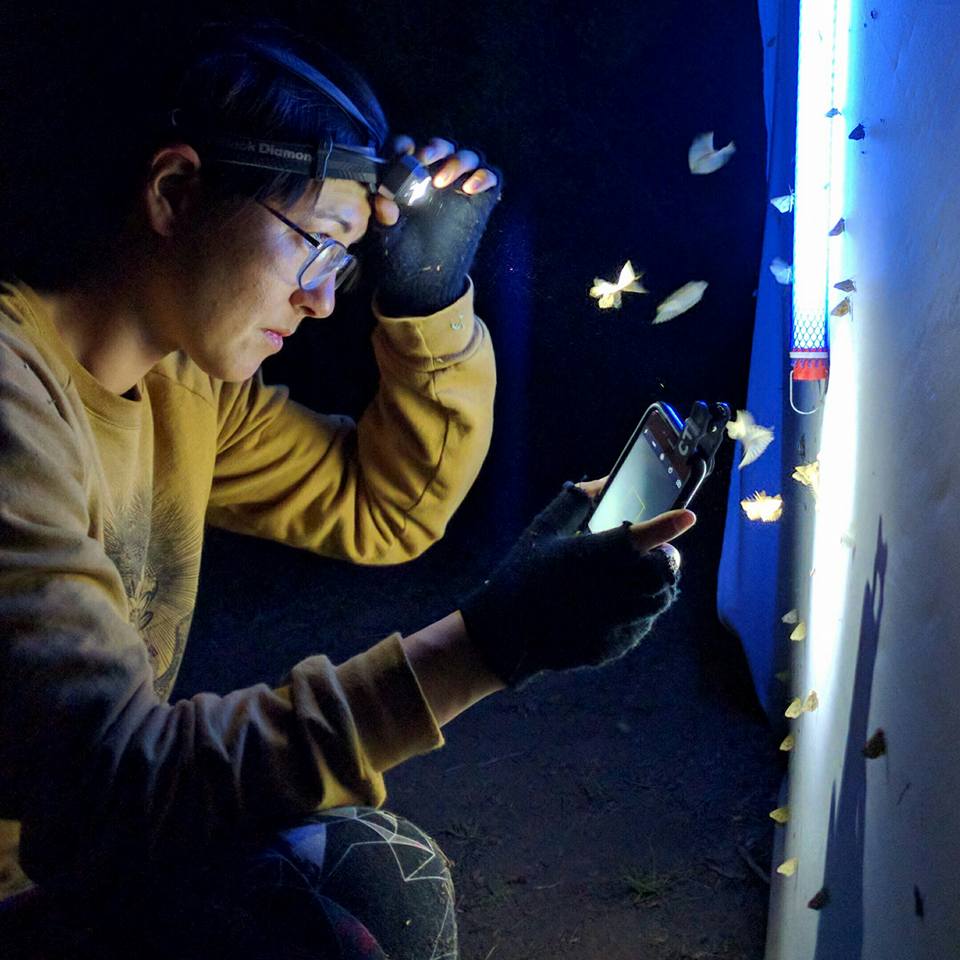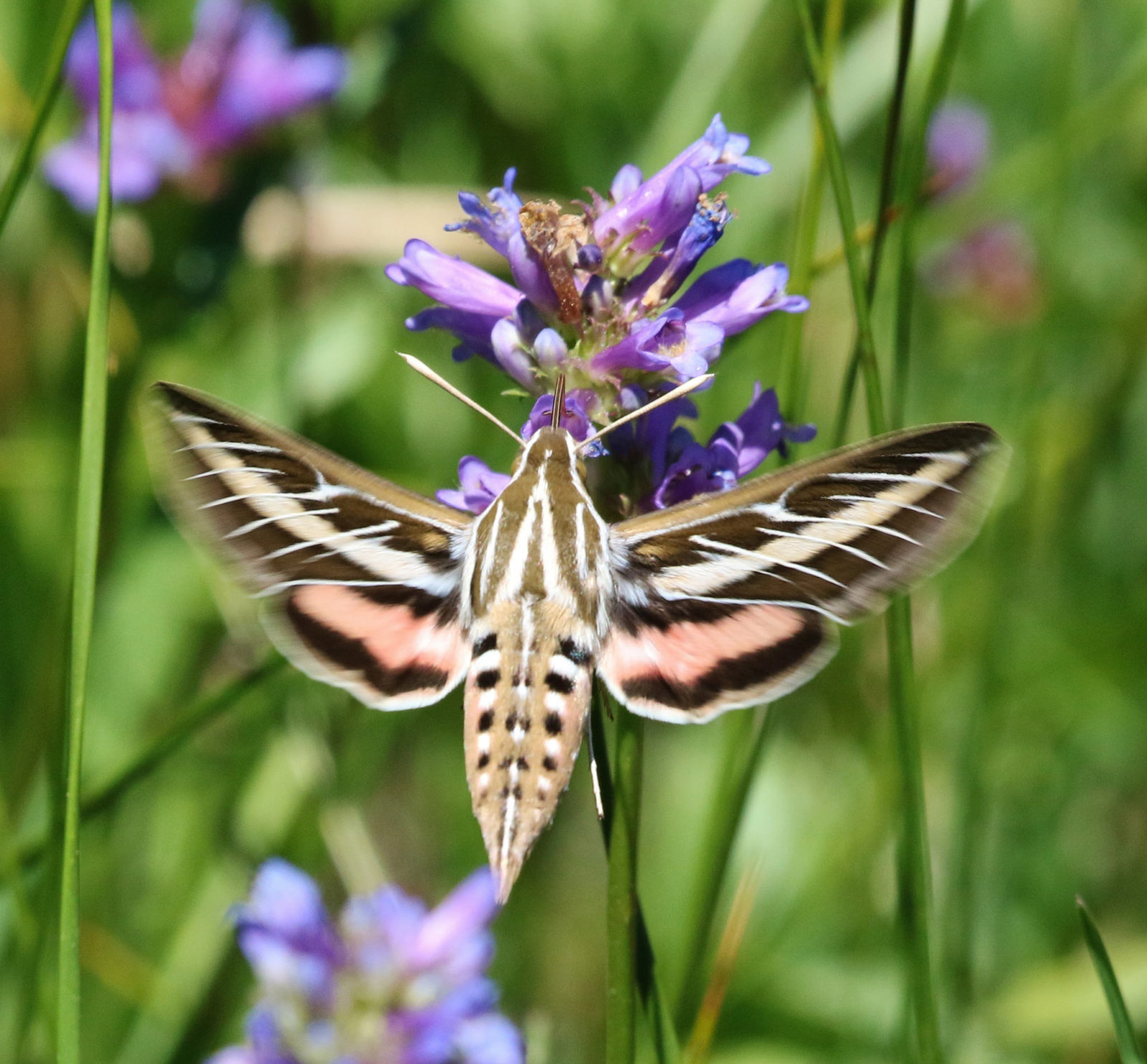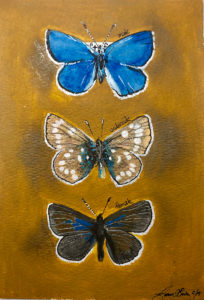Q: This moth visited me the other night. It was almost as big a a hummingbird. Can anyone ID it please? — Chris, Pacifica
Chris, you must have the makings of a naturalist. Your large fuzzy visitor is none other than the inimitable white-lined sphinx (Hyles lineata), a member of a family often called “hummingbird moths”! This busy giant (its wingspan averages about two to three inches, close an Anna’s hummingbird’s five) gets its nickname not only from its size, but its feeding habits. Flapping its wings furiously, the moth hovers at flowers and slurps up delicious nectar, looking very much like a hummingbird. This is a great example of convergent evolution, when two totally different organisms evolve similar adaptations. Just this spring I was able to record, in slow motion, several feeding at flowers in Bishop, California; while most moths are nocturnal, white-lined sphinxes and some other species will be active during the day. Below is the footage slowed to 40 percent of normal speed. Check out the beautiful pink underwings that are revealed when the moth is in flight.
White-lined sphinxes are one of the most abundant and noticeable moths in the Americas, with a range that spans both continents and population explosions that must be seen to be believed. In the spring of 2015 some friends and I were visiting the Mojave Desert and saw portly, white-lined sphinx caterpillars furiously consuming the leaves of nearly every plant; alas, it was almost impossible to not step on one while walking about. In fact, large masses of these caterpillars often cross roads en masse to find fresh food sources, creating slick and dangerous conditions when too many cars inevitably crush them. In contrast to many other butterflies and moths, white-lined sphinx caterpillars are able to eat a wide variety of plant hosts, so they can take advantage of boom years when the weather is good. Unlike their cousins, the tomato and tobacco hornworms, they’re not known to cause much harm to crops.
Encountering such a beautiful and impressive creature as a white-lined sphinx is always exciting, and I like to think of them as charismatic and easily visible ambassadors of the breathtakingly diverse world of moths. Both butterflies and moths belong to the insect order Lepidoptera, and while butterflies are the colorful, showy ones that people love, they make up only about one-tenth of the nearly 180,000 described lepidopteran species! And because many moths lack the long legs and proboscides of butterflies, they have to really root around in flowers, in the process covering themselves with pollen and thereby becoming important pollinators. In fact yucca plants, including the iconic Joshua tree, can only be pollinated by moths of the family Prodoxidae, and it’s a somewhat involved process. Butterflies, alas, are more incidental pollinators.
But if most moths are tiny and nocturnal, how does one get a good look at them? Lights, of course! For reasons scientists still don’t understand, many species of moths (including white-lined sphinxes) are attracted to lights, thus leading to the somewhat sedentary yet surprisingly exciting activity dubbed “mothing.” This usually involves setting up a white sheet between two trees and hanging a battery-powered UV light over it to attract your quarry. Then sit back while the photons draw in nature’s winged bounty. Most moths just perch on the sheet, bathing in the glow, so you’ll be able to get a good look at them. On a nice warm and calm night, you’ll find a surprising diversity of insects, and if you have a decent macro or hand lens, the subtle beauty and details of the moths will be revealed.

If you want to get your ‘mothing’ adventure started, California Center for Natural History Naturalist/Photographer/Inventor Damon Tighe has just published a portable DIY LED moth light how-to on the CCNH blog. He and others have already observed an impressive array of insects with these lights and are seeing if different insects are drawn to lights of different wavelengths. As you can see, the white-lined sphinx is just the tip of the proverbial moth iceberg.

A resident of Oakland, Tony Iwane is the Outreach Coordinator for iNaturalist and an interpretive naturalist for the California Center for Natural History. Check out his photos on Flickr and his nature observations.





